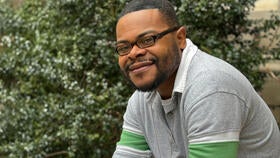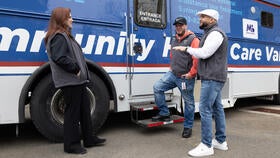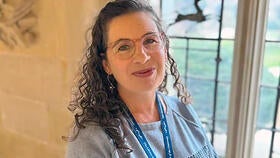
“When you hit that [1831] room… for me, it was like that ancestor spirituality flowed straight through me. To see those beautiful people up there [on the walls] …”
“That quote is one of hundreds of enthusiastic responses to the exhibition that we’ve received since it opened in February,” said Michael Morand, Beinecke Library’s director of community engagement and a curator of the exhibition “Shining Light on Truth: New Haven, Yale, and Slavery.”
“What this person is so moved by is the room in the museum where we represent the library of what could have been the first historically Black college in America were it not voted down in 1831 by white New Haveners, many of them leaders and alumni of Yale,” he said.
In June 2023, Morand was asked by Susan Gibbons, chief of staff to the president and vice provost for collections and scholarly communication, to take the lead on the exhibition. It is one of four ways in which Yale shared the findings of the Yale and Slavery Research Project, along with the book “Yale and Slavery: A History” by Sterling Professor of History David W. Blight with the Yale and Slavery Research Project; a special-topic walking tour that illuminates key sites on campus related to slavery and its legacies; and the Yale and Slavery website.
 Left to right (clockwise from left) Charles E. Warner Jr., Tubyez Cropper, Michael Morand, David Jon Walker, Jen Castellon-McEnerney, Hope McGrath.
Left to right (clockwise from left) Charles E. Warner Jr., Tubyez Cropper, Michael Morand, David Jon Walker, Jen Castellon-McEnerney, Hope McGrath.
What Morand and his team brought to life in the museum draws on, in his words, “generations of scholarship and community memory. The story we’re telling is about a constellation of people.” The university was intentional in housing the exhibition in a community museum and making it free to the public through August 2024.
“The exhibition also shows the power of collaboration within our library team,” added Morand, “and bears out what I always say about community engagement — if we’re doing anything by ourselves, we’re probably doing it wrong.”
Bringing history to life
 Michael Morand, Tubyez Cropper, and Charles Warner Jr.
Michael Morand, Tubyez Cropper, and Charles Warner Jr.
Morand became lead curator during his time as a member of the Yale and Slavery working group. In addition to doing research himself, he organized numerous public programs and authored a chapter in “Yale and Slavery: A History.” One of his first acts as curator was a call to Charles E. Warner Jr., who works with the New Haven Public Schools and has deep ties to the New Haven community. As a Beinecke community engagement fellow, Warner joined forces with Morand in curating the show, contributing, as Warner says, “ongoing knowledge about the Black history of New Haven as a life-long resident with a passion for historical narrative. My work as chair of the Dixwell Church History Committee and the Connecticut Freedom Trail is in line with the purpose of the project and its focus on the history of slavery.”
“Shining Light on Truth: New Haven, Yale, and Slavery” is free and open to the public through August 2024. The New Haven Museum, located at 114 Whitney Avenue in New Haven, is open Wednesday through Friday, 10:00 a.m. to 5:00 p.m., and Saturday, noon to 5:00 p.m.
As he worked on the exhibition, Warner was touched by Yale’s openness, particularly that everything unearthed was allowed to be brought to a conversation. “Some people might think that Yale, the big giant, would have loved to direct and determine all ways in which this project would proceed, but that was not my experience,” said Warner.
Morand also tapped David Jon Walker ’23 M.F.A. as design lead. Once Walker saw the documents with the names of enslaved and free Black people who helped build Connecticut Hall, along with other items, he began visualizing the narrative that was not yet tangible. “I thought about bringing forward materiality — being able to touch a garment, to smell something or be surrounded in a space,” he said. “Printing on fabric was to pay homage to the labor force at the time — the sweeps and washer women.”
He used the typeface Appeal that he created while in Yale’s Design MFA program, which he named after Abolitionist David Walker’s 1829 “Appeal to the Colored Citizens of the World.” David Jon Walker commissioned Ben Blount, a Black printer, to typeset the names of over 200 people who were enslaved to Yale’s early leaders, founders, and donors in an 1800s-style letterpress-printed list, and a sign painter hand painted the banner for the 1831 room. Robert Riggins III, a Black lumberjack, cut a slab of white oak to which Walker affixed runaway-slave newspaper ads.
 Michael Morand, Tubyez Cropper, Charles Warner Jr., Hope McGrath, David Jon Walker, and Jen Castellon-McEnerney.
Michael Morand, Tubyez Cropper, Charles Warner Jr., Hope McGrath, David Jon Walker, and Jen Castellon-McEnerney.
While digesting the content, there were moments when Walker had to overlook the trauma of people in the past so he could create something informative in a meaningful way. “Not in the sense that I was holding back emotions and wading through the mess,” he added, “but reminding myself of the greater meaning and the greater purpose of education, the higher meaning of what we were attempting to do.”
Tubyez Cropper, community engagement program manager for the Beinecke Library, and Jennifer Coggins, community engagement archivist, were responsible for setting up the 1831 library room. Cropper hung portraits of Black Yale students and New Haven citizens on the walls, determining how to place them, not uniformly, but almost as if a relative or friend were to take a seat, read the books, and become part of the journey of experiencing the past in the present. “The people on the walls are talking to each other and to the people that come into the room,” said Cropper.
Beginning the summer prior to the exhibition, Coggins, Warner, and Hope McGrath, lead researcher with the Yale and Slavery Research Project, explored biographies of Black students who attended Yale from the 1830s through the 1940s. They found 224 people and conducted research in Yale records as well as sources like Ancestry, Family Search, and digitized online material. Coggins, McGrath, and Warner, with the assistance of Yale College student Simone Felton, compiled the information on the students and wrote biographies. Coggins unearthed photos or images of as many students as possible and has so far found more 159. Coggins compiled the biographies and images into binders, available to browse in the 1831 College library room.
 David Jon Walker and Jennifer Castellon-McEnerney.
David Jon Walker and Jennifer Castellon-McEnerney.
Jen Castellon-McEnerney, the Beinecke’s events coordinator, worked with Yale Printing and Publishing Services to produce the custom designed binders, which were embossed with the seal Walker designed for the 1831 college. Castellon-McEnerney felt the powerful nature of the exhibit materials when she read the list of over 200 enslaved people connected to Yale. “It was very emotional for me, especially the individuals with no names on the list,” Castellon-McEnerney said. “It was heartbreaking to understand that a person who was part of our history did not have a name.”
When McGrath, who wrote two chapters and three interludes of “Yale and Slavery: A History,” joined the Beinecke team in September 2023, she helped Morand write and revise exhibition labels and researched 18th-century advertisements in Connecticut newspapers connected to slavery. Morand asked her to find 40 ads related to the sale of enslaved people or those seeking their freedom. She thought that would be impossible, but ultimately found many more, many of which are tacked to the piece of oak in the exhibition.
 Tubyez Cropper, Charles Warner Jr., and Hope McGrath.
Tubyez Cropper, Charles Warner Jr., and Hope McGrath.
Further reflection
McGrath marked the original advertisements, and Mary Ellen Budney, library service assistant, scanned them to make digital files so they could be printed. Handling the runaway slave advertisements was somewhat of a wake-up call for Budney. Born and raised in the Northeast, she thought that everyone in the region was an abolitionist at the time. “The effect of the advertisements was cumulative as I was scanning and reading them,” she said. “It was really a revelation to see the ads piled up on my desk.”
 Jennifer Coggins and Mary Ellen Budney.
Jennifer Coggins and Mary Ellen Budney.
Morand said when he stepped back and thought about everything the exhibition portrays — from the 1831 room to the names of the enslaved people who built Connecticut Hall and other Yale structures, to the portraits and biographies — among the stories he was most struck by is the fact that 90% of the Black men in Connecticut who could fight did fight in the Civil War, “sacrificing for the liberation of their people and for the salvation of the nation. That percentage outnumbered the percentage of white Yale students and graduates who signed up to serve.” Morand believes that without the participation and leadership of Black soldiers the nation would not have survived. “I think about this particularly,” said Morand, “because my husband is a great grandson of Sergeant Alfred Powers, one of the many Black patriots who fought for our nation. In our household, this history is close to home.”
The Constellations Project
Jennifer Coggins and Hope McGrath lead a Beinecke project dedicated to researching, understanding, and uplifting the stories of early Black pathfinders at Yale. It extends the research and reach of the Yale and Slavery project and the “Shining Light on Truth” exhibition. The Constellations Project: Early Black Lives at Yale, 1830-1940 aims to catalyze continued research, inquiry, and analysis. Aside from a few exceptional figures, the lives of these alumni — their accomplishments as well as the distinctive challenges they faced in slavery, under Jim Crow, and throughout the long civil rights movement — are not widely known.






